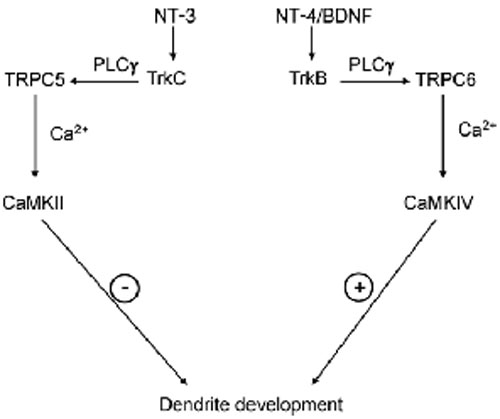Time:2012-07-06
On July 4, 2012, Dr. Yizheng Wang’s research group at the Institute of Neuroscience, Chinese Academy of Sciences, published a research article entitled “TRPC5 channel is the mediator of Neurotrophin-3 in regulating dendritic growth via CaMKIIa in rat hippocampal neurons” in the Journal of Neuroscience. This work was carried out by Dr. Zhuohao He and colleagues, under the supervision of Dr. Yizheng Wang.
Neurotrophin-3 (NT-3) is enriched in the central nervous system (CNS), where it plays many important roles. The intracellular Ca2+ ([Ca2+]i) changes due to extracellular Ca2+ influx are important for NT-3 to exert its physiological functions. However, the mechanism that enables NT-3 to induce Ca2+ influx remains largely unknown. Meanwhile, the transient receptor potential canonical (TRPC) channels, a subfamily of nonselective cation channels, emerged as a new route for [Ca2+]i elevation. Unlike the relatively wide distribution of other TRPCs, the distribution of TRPC5 is mainly restricted to the CNS. However, the physiological agonist for TRPC5 in the CNS remains largely unknown.
In this study, using immunostaining, RNA interference, time-lapse intracellular Ca2+ imaging, neuronal morphological analysis and biochemistry, researchers in Dr. Yizheng Wang’s lab found that TRPC5 protein and Tyrosine receptor kinase C (TrkC), the NT-3 receptor, exhibited similar temporal expression pattern in the rat hippocampus and subcellular colocalization in hippocampal neurons. Inhibition of TRPC5 prevented PLCg-dependent Ca2+ influx, reduced calmodulin-dependent kinase (CaMK)IIa activation and abolished the inhibition on dendritic growth induced by NT-3 in neurons. In contrast, the Ca2+ influx through TRPC6 triggered by the NT-4-TrkB-PLCg pathway promoted dendritic growth.
These findings revealed a mechanism by which NT-3 induces [Ca2+]i elevation and suggested NT-3 as a physiological activator for TRPC5 channels in the CNS. Furthermore, these results explored an interesting yin-yang regulation on neuronal dendritic growth, by which different neurotrophins stimulated distinct signaling modules to activate different Ca2+ channels and the downstream Ca2+ signaling effectors, leading to opposing effects on dendrite development.
This study was supported by grants from “973 Program” and National Natural Science Foundation of China.

The Ca2+ influx through TRPC5 triggered by NT-3-TrkC-PLCg activates CaMKII and initiates negative regulation of dendrite development. In contrast, the Ca2+ influx through TRPC6 triggered by NT-4/BDNF-TrkB-PLCg activates CaMKIV and initiates positive regulation of dendrite development.
 附件下载:
附件下载: